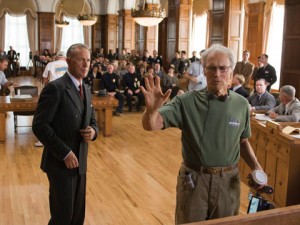
When director Clint Eastwood asked Michael Owens to oversee the visual effects for Changeling, he knew he didn’t have to recreate Iwo Jima, like he did previously for the director, or 19th-century New York, like he did for Martin Scorsese in Gangs of New York.
No, all Changeling needed was Los Angeles. The only problem was, it was set in the late 1920s, so one of Owens’ first tasks was to recreate an L.A. that no longer exists. The story follows a mother, played by Angelina Jolie, who insists that the boy “found” by the LAPD, after her son was kidnapped, was not her own.
Below the Line caught up with Owens—and Geoff Hancock, who oversaw digits for FX house CIS Vancouver—to ask about remaking L.A. as it used to be. We started by asking about what’s changed since the making Chinatown—perhaps Hollywood’s most definitive “L.A.” movie—which managed to recreate the L.A. of the mid-30s simply by finding buildings and neighborhoods that existed then, in the 1970s.
“Chinatown,” Owens notes, “creatively used real locations to their fullest extent without the use of visual effects,” but he adds “to that end, they limited their field of view to include the essential feel of the period and at the same time excluded anything modern from their view. The audience was never aware of this limitation due to the very clever and excellent craftsmanship of the filmmaking team. But today, with the advent of modern visual effects techniques, filmmakers have a much wider visual palette available to them to help them tell their story.
“In the case of Changeling, we were able to show wide daylight vistas of Los Angeles from the Hollywood Hills, along with shots of downtown streets that saw deep into the city. While I consider Chinatown a perfectly crafted movie, Changeling, is able to offer the audience a fuller historical view of the era which in turn hopefully affords a more engaging sense of the story.”
With such deep street views, then, how much of a role did pre-vis play in figuring out how much of “old L.A.”—and what parts—to show?
“For certain scenes we mocked up a pre-visualization still of the shot to help everyone involved have a better understanding of what the shot would look like.
Production designer James Murakami and his art department collected a great many historical still photographs of the era,” Owens says. “We then coordinated the Universal backlot foreground sets and the L.A. set locations to be the starting points for designing the digitally created backgrounds, which included Red Car trolleys, period automobiles, trucks, crowds, individual people, etcetera. By design and prior to shooting on the set, we would all know where the practicals started and ended and where visual effects would take over.”
But that wasn’t the only use for those still photos. Hancock adds that “CIS Vancouver collected together all the photographic reference material gathered by the art department, along with texture references shot on location of vehicles, buildings and costumes. Romain Bayle, our internal art director, organized all this vast imagery creating style sheets and concept art to guide the digital set builders in creation of the backlot extensions. Modern satellite and period aerial imagery was used to help define appropriate geography for matte paintings and set extensions.”
But satellite imagery wasn’t the only modern tool. There was the software Owens and Hancock were using, and the question of how they could, as Hancock says, “leverage our past experiences with Massive software to push the realism of people’s movements and details of the renders to allow CG pedestrians to intermingle with real extras within the first block of the Universal backlot.
“At House of Moves in Los Angeles, we worked closely with Philipp Hartmann and motion capture director Michelle Ladd to capture the personalities of nine distinct actors to allow for natural behavior of crowds. We needed to focus on how people moved differently in that time period, and what were the subtleties of the animation that would allow it to intercut with real extras.”
Hancock also adds that “Kristin Dearholt, our digital production manager worked closely with Michael to complete closed-circuit color management,” so he could “review materials from a distance with confidence. Using a mix of in-house software, Aperture and Framecycler, we were able to ensure that images from our film lab and digital projectors looked identical to images at a 2K review station or sent remotely to Michael. Zbrush and Maya were used to create high-res digital actors that became source models and textures for Massive crowd agents.”
The past then, is a lot less simple than it used to be, at least in terms of recreation. But Owens didn’t want the hard work in creating that “simpler time” to call attention to itself: “Prior to preproduction, Clint Eastwood, producer Rob Lorenz and I got together and discussed which scenes in the movie we thought might be enhanced by expanding their environments through the use of visual effects. We were all in agreement that whenever used, the effects were to be a peripheral enhancement and should not draw attention to themselves. An exception to this was the opening shot which was designed to establish the era and to suggest the geographical location of the (Jolie character’s) home.
“We used a couple of modern books with great historical photos of L.A. as reference and inspiration during these discussions. From there, we were able to make and/or refine decisions regarding the scope of the practical locations, sets and the backlot and at the same time have a better idea of how the movie would feel with these additions.”
Unlike the changeling brought home to the grieving mother, the movie at least feels “right.” Given how clear the air was then, and how well traffic moved, too bad that, like the Changeling, that vanished L.A. is no longer the real deal.
Except on screen.





